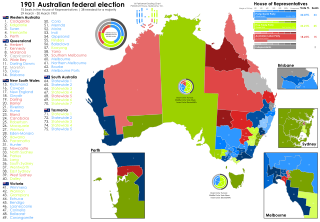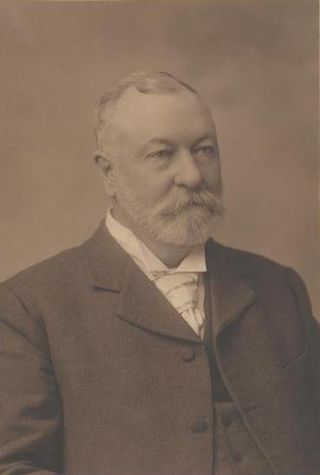Related Research Articles
This is a list of the members of the Australian House of Representatives in the First Australian Parliament, which was elected on 29 and 30 March 1901. There were 75 members, as required by the Constitution, as near as possible to twice the number of Senators which was then 36. South Australia and Tasmania had not been divided into electoral divisions in 1901 which resulted in the particular state voting as a single electorate. There were seven members for South Australia, and five members for Tasmania elected.

The 1901 Australian federal election for the inaugural Parliament of Australia was held in Australia on Friday 29 March and Saturday 30 March 1901. The elections followed Federation and the establishment of the Commonwealth of Australia on 1 January 1901. All 75 seats in the Australian House of Representatives, six of which were uncontested, as well as all 36 seats in the Australian Senate, were up for election.
This is a list of the members of the Australian Senate in the First Australian Parliament, which was elected on 29 March 1901. There were 36 senators in this initial parliament. Terms were deemed to start on 1 January 1901. In accordance with section 13 of the Constitution, the Senate resolved that in each State the three senators who received the most votes would sit for a six-year term, finishing on 31 December 1906 while the other half would sit for a three-year term, finishing on 31 December 1903. The process for filing of casual vacancies was complex, with an initial appointment followed by an election. The status of political parties varied, being national, State based, and informal.

The 1903 Australian federal election was held in Australia on 16 December 1903. All 75 seats in the House of Representatives, and 19 of the 36 seats in the Senate were up for election. The incumbent Protectionist Party minority government led by Prime Minister Alfred Deakin retained the most House of Representatives seats of the three parties and retained government with the parliamentary support of the Labour Party led by Chris Watson. The Free Trade Party led by George Reid remained in opposition.

The 1906 Australian federal election was held in Australia on 12 December 1906. All 75 seats in the House of Representatives, and 18 of the 36 seats in the Senate were up for election. The incumbent Protectionist Party minority government led by Prime Minister Alfred Deakin retained government, despite winning the fewest House of Representatives votes and seats of the three parties. Parliamentary support was provided by the Labour Party led by Chris Watson, while the Anti-Socialist Party, led by George Reid, remained in opposition.
The Division of South Australia was an Australian electoral division covering South Australia. The seven-member statewide seat existed from the inaugural 1901 election until the 1903 election. Each elector cast seven votes. Unlike most of the other states, South Australia had not been split into individual single-member electorates. The other exception was the five-member Division of Tasmania. The statewide seats were abolished at a redistribution conducted two months prior to the 1903 election and were subsequently replaced with single-member divisions, one per displaced member, with each elector now casting a single vote.

Thomas Macdonald-Paterson was an Australian politician, a member of the Parliament of Queensland, and later, the Parliament of Australia.
This article provides information on candidates who stood for the 1903 Australian federal election. The election was held on 16 December 1903.
This article provides information on candidates who stood for the 1906 Australian federal election. The election was held on 12 December 1906.
This article provides information on candidates who stood for the 1910 Australian federal election. The election was held on 13 April 1910.
This article provides information on candidates who stood for the 1913 Australian federal election. The election was held on 31 May 1913.
This article provides information on candidates who stood for the 1914 Australian federal election. The election was held on 5 September 1914.
This article provides information on candidates who stood for the 1922 Australian federal election. The election was held on 16 December 1922.
This article provides information on candidates who stood for the 1949 Australian federal election. The election was held on 10 December 1949.
The following tables show state-by-state results in the Australian Senate at the 1901 federal election. Senators total 17 Free Trade, 11 Protectionist, and eight Labour. The terms were deemed to start on 1 January 1901. In each state, the first three elected received full six-year terms, and the three senators elected with the lowest number of votes retire after three years.

Chanter v Blackwood and the related case of Maloney v McEacharn were a series of decisions of the High Court of Australia, sitting as the Court of Disputed Returns arising from the 1903 federal election for the seats of Riverina and Melbourne in the House of Representatives. Chanter v Blackwood , and Maloney v McEacharn , determined questions of law as to the validity of certain votes. In Chanter v Blackwood Griffith CJ held that 91 votes were invalid and because this exceeded the majority, the election was void, while Chanter v Blackwood dealt with questions of costs. In Maloney v McEacharn more than 300 votes were found to be invalid and the parties agreed it was appropriate for the election to be declared void.
The Australian states each elected three members of the Australian Senate at the 1910 federal election to serve a six-year term starting on 1 July 1910.
This is a list of electoral results for the Australian Senate in Victoria since Federation in 1901.
This is a list of electoral results for the Australian Senate in Tasmania since Federation in 1901.
This is a list of electoral results for the Australian Senate in Queensland since Federation in 1901.
References
- Adam Carr's Election Archive - House of Representatives 1901
- Adam Carr's Election Archive - Senate 1901
- Hawker, Geoffrey (2002). Politicians All: The Candidates for the Australian Commonwealth Election 1901 - A Collective Biography. Australian Institute of Political Science. ISBN 090933191X.